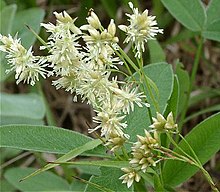Snow-white grove
| Snow-white grove | ||||||||||||
|---|---|---|---|---|---|---|---|---|---|---|---|---|

Snow-white grove ( Luzula nivea ) |
||||||||||||
| Systematics | ||||||||||||
|
||||||||||||
| Scientific name | ||||||||||||
| Luzula nivea | ||||||||||||
| ( L. ) DC. |
The snow-white grove ( Luzula nivea ) or snow grove is a herbaceous plant belonging to the rush family (Juncaceae). The regionally by many as Schneemarbel called woodrush is characterized by its snow-white petals.
Distribution and location
The snow-white grove is a European species and occurs mainly in the Alps and the Pyrenees .
It grows in species-poor beech and oak -beech forests, sometimes also in mixed coniferous forest communities. It occurs in communities of oak-birch forests (Quercion robori-petraeae), oak- hornbeam forests (Carpinion betuli) and in fir - spruce forests (Vaccinio-Abietenion). The penumbra to shade plant prefers moderately fresh, base-rich, low-lime, neutral to moderately acidic, moldy, humus clay soils .
description
The plant is a perennial , runners-up hemicryptophyte with a loose grass growth. It reaches heights of growth between 10 and 30 centimeters. The stems grow upright. The grass-green leaves are 4 millimeters wide and about 30 centimeters long. They have long eyelashes on the edge and on the surface. The leaf sheaths are closed and also long hairy at the vaginal mouth.
The terminal inflorescence is a spiral with tightly packed, upright branches. The inflorescence is always surmounted by at least one support sheet . The individual flowers are large and are in groups of six to 20. The petals (perigone) are snow-white, 4 to 6 millimeters long and lanceolate, pointed. The outer ones are significantly shorter. The stylus is much longer than the ovary . The fruit shape is a single-compartment brown capsule . It has a short tip and is much shorter than the petals. The seeds have fatty appendages ( elaiosomes ) which are used exclusively for the purpose of spreading by ants ( myrmecochory ). The snow-white grove blooms from June to August.
The number of chromosomes is 2n = 12.
Others
The snow-white grove is cultivated as an ornamental plant mainly in shady gardens. The decorative inflorescences are suitable for dry bouquets.
literature
- J. Grau, B. Kremer, BM Möseler, G. Rambold & D. Triebel: Grasses. Mosaik Verlag, Munich 1990, ISBN 3-576-10702-9
- Henning Haeupler , Thomas Muer: picture atlas of the fern and flowering plants of Germany (= the fern and flowering plants of Germany. Volume 2). Published by the Federal Agency for Nature Conservation. Ulmer, Stuttgart 2000, ISBN 3-8001-3364-4 , pp. 663-667.
- E. Oberdorfer: Plant-sociological excursion flora. Ulmer, Stuttgart 1994. ISBN 3-8252-1828-7 .
Individual evidence
- ↑ Rafaël Govaerts (ed.): Luzula nivea. In: World Checklist of Selected Plant Families (WCSP) - The Board of Trustees of the Royal Botanic Gardens, Kew . Retrieved October 13, 2016.
- ↑ a b Erich Oberdorfer : Plant-sociological excursion flora for Germany and neighboring areas . With the collaboration of Angelika Schwabe and Theo Müller. 8th, heavily revised and expanded edition. Eugen Ulmer, Stuttgart (Hohenheim) 2001, ISBN 3-8001-3131-5 , pp. 153 .
Web links
- Snow-white grove. In: FloraWeb.de.
- Snow-white grove . In: BiolFlor, the database of biological-ecological characteristics of the flora of Germany.
- Profile and distribution map for Bavaria . In: Botanical Information Hub of Bavaria .
- Luzula nivea (L.) DC., Map for distribution in Switzerland In: Info Flora , the national data and information center for Swiss flora .
- Thomas Meyer: Data sheet with identification key and photos at Flora-de: Flora von Deutschland (old name of the website: Flowers in Swabia )


